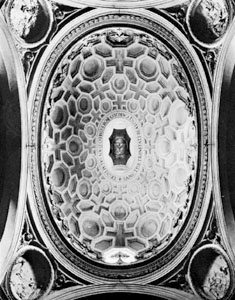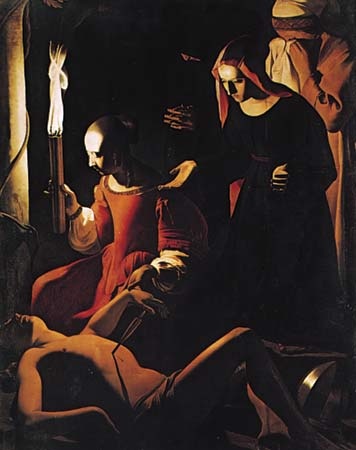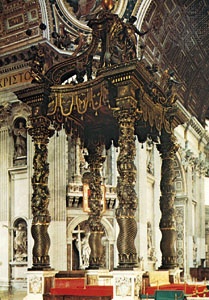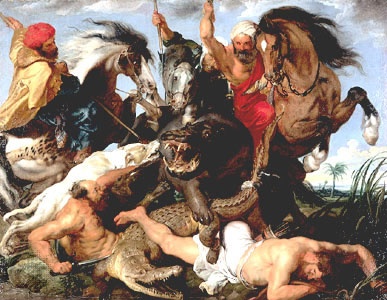Baroque period
art
era in the history of the Western arts roughly coinciding with the 17th century. Its earliest manifestations, which occurred in Italy, date from the latter decades of the 16th century, while in some regions, notably Germany and colonial South America, certain of its culminating achievements did not occur until the 18th century. The work that distinguishes the Baroque period is stylistically complex, even contradictory. In general, however, the desire to evoke emotional states by appealing to the senses, often in dramatic ways, underlies its manifestations. Some of the qualities most frequently associated with the Baroque are grandeur, sensuous richness, drama, vitality, movement, tension, emotional exuberance, and a tendency to blur distinctions between the various arts.
The term Baroque probably ultimately derived from the Italian word barocco, which was a term used by philosophers during the Middle Ages to describe an obstacle in schematic logic. Subsequently the word came to denote any contorted idea or involuted process of thought. Another possible source is the Portuguese word barroco (Spanish barrueco), used to describe an irregular or imperfectly shaped pearl, and this usage still survives in the jeweler's term baroque pearl. In art criticism the word Baroque came to be used to describe anything irregular, bizarre, or otherwise departing from established rules and proportions. This biased view of 17th-century art styles was held with few modifications by critics from Johann Winckelmann to John Ruskin and Jacob Burckhardt, and until the late 19th century the term always carried the implication of odd, grotesque, exaggerated, and overdecorated. It was only with Heinrich Wölfflin (Wölfflin, Heinrich)'s pioneer study Renaissance und Barock (1888) that Baroque was used as a stylistic designation rather than as a term of thinly veiled abuse, and a systematic formulation of the characteristics of Baroque style was achieved.
 Because the arts present such diversity within the Baroque period, their unifying characteristics must be sought in relation to the era's broader cultural and intellectual tendencies, of which three are most important for their effect on the arts. The first of these was the emergence of the Counter-Reformation and the expansion of its domain, both territorially and intellectually. By the last decades of the 16th century the refined, courtly style known as Mannerism had ceased to be an effective means of expression, and its inadequacy for religious art was being increasingly felt in artistic circles. To counter the inroads made by the Reformation, the Roman Catholic Church after the Council of Trent (1545–63) adopted a propagandistic stance in which art was to serve as a means of extending and stimulating the public's faith in the church. To this end the church adopted a conscious artistic program whose art products would make an overtly emotional and sensory appeal to the faithful. The Baroque style that evolved from this program was paradoxically both sensuous and spiritual; while a naturalistic treatment rendered the religious image more accessible to the average churchgoer, dramatic and illusory effects were used to stimulate piety and devotion and convey an impression of the splendour of the divine. Baroque church ceilings thus dissolved in painted scenes that presented vivid views of the infinite to the observer and directed the senses toward heavenly concerns.
Because the arts present such diversity within the Baroque period, their unifying characteristics must be sought in relation to the era's broader cultural and intellectual tendencies, of which three are most important for their effect on the arts. The first of these was the emergence of the Counter-Reformation and the expansion of its domain, both territorially and intellectually. By the last decades of the 16th century the refined, courtly style known as Mannerism had ceased to be an effective means of expression, and its inadequacy for religious art was being increasingly felt in artistic circles. To counter the inroads made by the Reformation, the Roman Catholic Church after the Council of Trent (1545–63) adopted a propagandistic stance in which art was to serve as a means of extending and stimulating the public's faith in the church. To this end the church adopted a conscious artistic program whose art products would make an overtly emotional and sensory appeal to the faithful. The Baroque style that evolved from this program was paradoxically both sensuous and spiritual; while a naturalistic treatment rendered the religious image more accessible to the average churchgoer, dramatic and illusory effects were used to stimulate piety and devotion and convey an impression of the splendour of the divine. Baroque church ceilings thus dissolved in painted scenes that presented vivid views of the infinite to the observer and directed the senses toward heavenly concerns. The second tendency was the consolidation of absolute monarchies, accompanied by a simultaneous crystallization of a prominent and powerful middle class, which now came to play a role in art patronage. Baroque palaces were built on an expanded and monumental scale in order to display the power and grandeur of the centralized state, a phenomenon best displayed in the royal palace and gardens at Versailles (Versailles, Palace of). Yet at the same time the development of a picture market for the middle class and its taste for realism may be seen in the works of the brothers Le Nain and Georges de La Tour in France and in the varied schools of 17th-century Dutch painting.
The second tendency was the consolidation of absolute monarchies, accompanied by a simultaneous crystallization of a prominent and powerful middle class, which now came to play a role in art patronage. Baroque palaces were built on an expanded and monumental scale in order to display the power and grandeur of the centralized state, a phenomenon best displayed in the royal palace and gardens at Versailles (Versailles, Palace of). Yet at the same time the development of a picture market for the middle class and its taste for realism may be seen in the works of the brothers Le Nain and Georges de La Tour in France and in the varied schools of 17th-century Dutch painting.The third tendency was a new interest in nature and a general broadening of human intellectual horizons, spurred by developments in science and by explorations of the globe. These simultaneously produced a new sense both of human insignificance (particularly abetted by the Copernican (Copernican system) displacement of the Earth from the centre of the universe) and of the unsuspected complexity and infinitude of the natural world. The development of 17th-century landscape painting, in which humans are frequently portrayed as minute figures in a vast natural setting, is indicative of this changing awareness of the human condition.
 The arts present an unusual diversity in the Baroque period, chiefly because currents of naturalism and classicism (Classicism and Neoclassicism) coexisted and intermingled with the typical Baroque style. Indeed, Annibale Carracci (Carracci, Annibale) and Caravaggio, the two Italian painters who decisively broke with Mannerism in the 1590s and thus helped usher in the Baroque style, painted, respectively, in classicistic and realist modes. A specifically Baroque style of painting arose in Rome in the 1620s and culminated in the monumental painted ceilings and other church decorations of Pietro da Cortona, Guido Reni, Il Guercino, Domenichino, and countless lesser artists. The greatest of the Baroque sculptor-architects was Gian Lorenzo Bernini (Bernini, Gian Lorenzo), who designed both the baldachin with spiral columns above the altar of St. Peter's in Rome and the vast colonnade fronting that church. Baroque architecture (Western architecture) as developed by Bernini, Carlo Maderno, Francesco Borromini, and Guarino Guarini emphasized massiveness and monumentality, movement, dramatic spatial and lighting sequences, and a rich interior decoration using contrasting surface textures, vivid colours, and luxurious materials to heighten the structure's physical immediacy and evoke sensual delight.
The arts present an unusual diversity in the Baroque period, chiefly because currents of naturalism and classicism (Classicism and Neoclassicism) coexisted and intermingled with the typical Baroque style. Indeed, Annibale Carracci (Carracci, Annibale) and Caravaggio, the two Italian painters who decisively broke with Mannerism in the 1590s and thus helped usher in the Baroque style, painted, respectively, in classicistic and realist modes. A specifically Baroque style of painting arose in Rome in the 1620s and culminated in the monumental painted ceilings and other church decorations of Pietro da Cortona, Guido Reni, Il Guercino, Domenichino, and countless lesser artists. The greatest of the Baroque sculptor-architects was Gian Lorenzo Bernini (Bernini, Gian Lorenzo), who designed both the baldachin with spiral columns above the altar of St. Peter's in Rome and the vast colonnade fronting that church. Baroque architecture (Western architecture) as developed by Bernini, Carlo Maderno, Francesco Borromini, and Guarino Guarini emphasized massiveness and monumentality, movement, dramatic spatial and lighting sequences, and a rich interior decoration using contrasting surface textures, vivid colours, and luxurious materials to heighten the structure's physical immediacy and evoke sensual delight.Pronounced classicizing tendencies subdued the Baroque impulse in France, as is evident in the serious, logical, orderly paintings of Nicolas Poussin (Poussin, Nicolas) and the somewhat more sumptuous works of Charles Le Brun and the portraitists Hyacinthe Rigaud and Nicolas de Largillière. French architecture is even less recognizably Baroque in its pronounced qualities of subtlety, elegance, and restraint. Baroque tenets were enthusiastically adopted in staunchly Roman Catholic Spain, however, particularly in architecture. The greatest of the Spanish builders, José Benito Churriguera, shows most fully the Spanish interest in surface textures and lush detail. He attracted many followers, and their adaptations of his style, labeled Churrigueresque, spread throughout Spain's colonies in the Americas and elsewhere. Diego Velázquez and other 17th-century Spanish painters used a sombre but powerful naturalistic approach that bore little direct relation to the mainstream of Baroque painting.
 The Baroque made only limited inroads into northern Europe, notably in what is now Belgium. That Spanish-ruled, largely Roman Catholic region's greatest master was the painter Peter Paul Rubens (Rubens, Peter Paul), whose tempestuous diagonal compositions and ample, full-blooded figures are the epitome of Baroque painting. The elegant portraits of Anthony Van Dyck and the robust figurative works of Jacob Jordaens emulated Rubens's example. Art in Holland was conditioned by the realist tastes of its dominant middle-class patrons, and thus both the innumerable genre and landscape painters of that country and such towering masters as Rembrandt and Frans Hals remained independent of the Baroque style in important respects. The Baroque did have a notable impact in England, however, particularly in the churches and palaces designed, respectively, by Sir Christopher Wren and Sir John Vanbrugh.
The Baroque made only limited inroads into northern Europe, notably in what is now Belgium. That Spanish-ruled, largely Roman Catholic region's greatest master was the painter Peter Paul Rubens (Rubens, Peter Paul), whose tempestuous diagonal compositions and ample, full-blooded figures are the epitome of Baroque painting. The elegant portraits of Anthony Van Dyck and the robust figurative works of Jacob Jordaens emulated Rubens's example. Art in Holland was conditioned by the realist tastes of its dominant middle-class patrons, and thus both the innumerable genre and landscape painters of that country and such towering masters as Rembrandt and Frans Hals remained independent of the Baroque style in important respects. The Baroque did have a notable impact in England, however, particularly in the churches and palaces designed, respectively, by Sir Christopher Wren and Sir John Vanbrugh. The last flowering of the Baroque was in largely Roman Catholic southern Germany and Austria, where the native architects broke away from Italian building models in the 1720s. In ornate churches, monasteries, and palaces designed by J.B. Fischer von Erlach, J.L. von Hildebrandt, the Asam brothers, Balthasar Neumann, and Dominikus Zimmermann, an extraordinarily rich but delicate style of stucco decoration was used in combination with painted surfaces to evoke subtle illusionistic effects.
The last flowering of the Baroque was in largely Roman Catholic southern Germany and Austria, where the native architects broke away from Italian building models in the 1720s. In ornate churches, monasteries, and palaces designed by J.B. Fischer von Erlach, J.L. von Hildebrandt, the Asam brothers, Balthasar Neumann, and Dominikus Zimmermann, an extraordinarily rich but delicate style of stucco decoration was used in combination with painted surfaces to evoke subtle illusionistic effects.One of the most dramatic turning points in the history of music (music, Western) occurred at the beginning of the 17th century, with Italy again leading the way. While the stile antico, the universal polyphonic style of the 16th century, continued, it was henceforth reserved for sacred music, while the stile moderno, or nuove musiche—with its emphasis on solo voice, polarity of the melody and the bass line, and interest in expressive harmony—developed for secular usage. The expanded vocabulary allowed for a clearer distinction between sacred and secular music as well as between vocal and instrumental idioms, and national differences became more pronounced. The Baroque period in music, as in other arts, therefore, was one of stylistic diversity. The opera, oratorio, and cantata were the most important new vocal forms, while the sonata, concerto, and overture were created for instrumental music. Claudio Monteverdi (Monteverdi, Claudio) was the first great composer of the “new music.” He was followed in Italy by Alessandro Scarlatti and Giovanni Pergolesi. The instrumental tradition in Italy found its great Baroque composers in Arcangelo Corelli, Antonio Vivaldi, and Giuseppe Tartini. Jean-Baptiste Lully, a major composer of opera, and Jean Philippe Rameau were the masters of Baroque music in France. In England the total theatrical experience of the Stuart masques was followed by the achievements in vocal music of the German-born, Italian-trained George Frideric Handel, while his countryman Johann Sebastian Bach developed Baroque sacred music in Germany. Other notable German Baroque composers include Heinrich Schütz, Dietrich Buxtehude, and Georg Philipp Telemann.
The literature that may specifically be called Baroque may be seen most characteristically in the writings of Giambattista Marino in Italy, Luis de Góngora in Spain, and Martin Opitz in Germany. English Metaphysical poetry, most notably much of John Donne's, is allied with Baroque literature. The Baroque period ended in the 18th century with a transition of its characteristic style into the lighter, less dramatic, more overtly decorative Rococo style.
- Ipiutak culture
- iPod
- Ipoh
- Ipomoea
- Ippitsusai Bunchō
- Ippolito de' Medici
- Ippolito Pindemonte
- Ippolitov-Ivanov, Mikhail
- iproniazid
- Ipsen, Bodil
- Ipsus, Battle of
- Ipswich
- Ipuwer
- IQ
- Iqaluit
- Iqbal, Javed
- Iqbāl, Sir Muḥammad
- Iquique
- Iquitos
- iqṭāʿ
- Ira Frederick Aldridge
- Ira Gershwin
- Ira Murchison
- Iran
- Iran, ancient